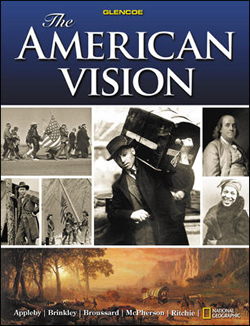
The American Vision © 2008Chapter 16: World War I and Its AftermathChapter OverviewsThis chapter examines the events that led the United States into World War I and looks at how the war impacted American society. Section 1 discusses the events that pushed the United States into World War I. In 1914 tensions between nations of Europe had led to alliances, militarism, and nationalism. That same year, the heir to the Austro-Hungarian throne was assassinated, and the alliances launched into the first world war. The Allies—Russia, France, Italy, and Britain—squared off against the Central Powers—Germany, Austria-Hungary, the Ottoman Empire, and Bulgaria. Wilson was determined that the United States would remain neutral even though American ties to Allied heritage, business, and finances swayed many to sympathize with the Allied cause. When German U-boats sank passenger liners with Americans onboard, Wilson issued strong warnings and secured a pledge from Germany that kept the peace a little longer. His peacekeeping efforts won him reelection, but the peace would not last long. A message indicating a Mexican-German alliance and another series of U-boat attacks finally pushed Wilson to ask for a declaration of war on April 2, 1917. Section 2 describes how the United States mobilized to fight World War I. When the United States declared war on Germany, Americans at home united to support the war. Congress created special boards to coordinate the efforts of business and labor. To fund the war effort, the government raised taxes, instituted new taxes, and sold bonds. While soldiers fought the war overseas, the Committee on Public Information used propaganda to urge cooperation at home. Selective service, a new conscription system, increased military forces. Women served in the military for the first time, a "Great Migration" of African Americans and Mexican Americans headed north to take wartime factory jobs. In their eagerness to support the war, legislators passed laws that curtailed citizens' civil liberties, and a climate of suspicion settled over not only German Americans, but also labor activists, socialists, and pacifists. Section 3 looks at the battles of World War I and the end of the war. New technologies and old-fashioned strategies resulted in heavy casualties and a devastated Europe by the spring of 1917. When American doughboys marched into the European stalemate, Allied morale lifted. The Bolshevik Revolution pulled Russia out of the war and allowed Germany to focus its forces in the west. A massive German offensive pushed into French territory, but American and French forces blocked the German drive. Massive counterattacks and an American offensive in the Argonne Forest pushed the Germans back and shattered their defenses. As the Central Powers crumbled, Germany signed an armistice. While the Treaty of Versailles treated Germany more harshly than Wilson's Fourteen Points plan for peace, it still called for the creation of the League of Nations—an international peacekeeping organization. Wilson returned home anxious to win approval for the treaty, but the Senate rejected the treaty along with his League of Nations. Section 4 reviews the turbulent aftermath of World War I. When the government removed its economic restrictions from businesses and consumers, demand increased and inflation set in. Workers wanted increased wages to keep up with inflation, and a series of strikes broke out. The rise of communism in Europe caused many Americans to wonder if Communists or foreign radicals had inspired the strikes. A Red Scare spread nationwide as Americans worried that Communists would seize power. A special government division investigated thousands of foreign residents and deported nearly 600 of them, often disregarding their civil liberties. As the Red Scare influenced attitudes about immigrants, frustration and racism led to violence between whites and African Americans. Weary of reform and reeling from the events of recent years, voters hoped to return to "normalcy" with the election of Warren G. Harding in 1920. |  |















